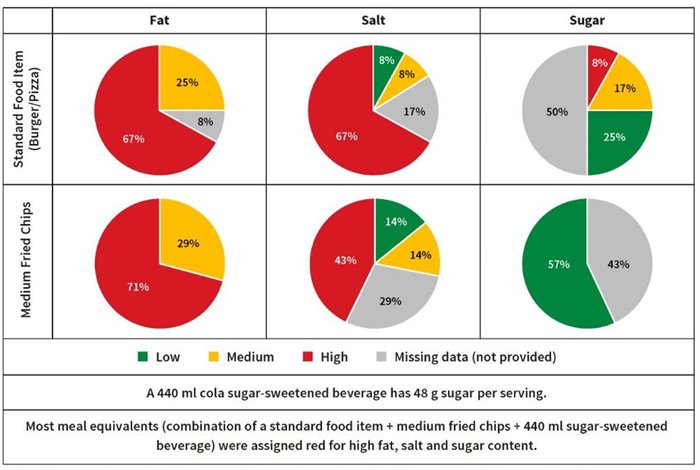Nutrition-related chronic diseases such as diabetes, hypertension, and cardiovascular diseases, remain a serious health issue. In the near future, these diseases are likely to become increasingly prevalent in developing countries like South Africa due to rapid and unplanned urbanisation.
Urbanisation is the main driver of the obesity pandemic and associated chronic diseases. This is because urbanisation comes with unhealthy lifestyle changes, including increased consumption of ultra-processed and energy-dense foods which are generally unhealthy. A large proportion of these unhealthy foods are fast foods, which are convenient to obtain at relatively low prices but are generally high in energy, fat, salt and even sugar.
Nutritional labelling of fast foods has been seen as an effective way of assisting consumers to make healthier food choices. Research shows that in the absence of nutritional labels, consumers tend to estimate nutrient content poorly. As a result, a host of countries have made it mandatory for fast-food outlets to provide nutritional information. Examples include the US, Canada, Australia, Ireland, Saudi Arabia, South Korea, Taiwan and United Arab Emirates.
However, African countries lag behind. None have introduced mandatory nutritional labelling of fast foods. South Africa is no exception. It has no laws or regulations requiring fast-food restaurants to provide any form of nutritional information to their consumers.
In our recent study we investigated two things: do South African fast-food restaurants provide nutritional information to the public? And secondly, we looked at the nutritional content of fast foods offered in South Africa.
We looked at the websites of 31 fast food restaurants in the country. We contacted the outlets when no information was found on their websites. Our findings showed that about 58% of the biggest South African fast-food restaurants provided nutritional information. This was mostly made accessible through the restaurants’ websites, but a few restaurants made it available only on request.
A third of the restaurants that provided the nutritional information were international franchises. This suggests that some of the nutritional information had been compiled in response to regulations from other countries where they also operate.
On the nutritional content we found that all meal combinations exceeded the total recommended energy, carbohydrates, sugar and salt content, and most also exceeded the recommended fat content. These levels are set by the National Department of Health for individuals four years and older.
We concluded that the South African government should introduce regulations that mandate nutritional labelling of fast foods. This will help consumers make informed dietary choices. It is important that the nutritional labelling is easily understood by all South African.
Edwin Kwong, Joanna Williams, Phillip Baker, Rob Moodie and Thiago M Santos 22 Oct 2021
Nutritional content
In our research we described the nutritional information of standard fast-food items (burgers or pizzas) and meal combinations (burger/pizza + medium fried chips + a 440 ml sugar sweetened beverage) across the fast-food restaurants.
Burgers and pizzas were high in protein. Some were also high in fat and salt, as indicated by percentages of the nutritional reference ranges above 30% level.
All meal combinations exacerbated the total energy, carbohydrates, sugar, and salt content, and mostly fat.
In the absence of nutritional labels, consumers tend to estimate nutrient content poorly. Consumers are often forced to rely on portion sizes and on the perception that similar food types contain similar nutrients.
For example, the nutritional content of similar looking food items may vary in nutrient quality due to different ingredients and preparation methods used by each restaurant. This variation highlights the importance of nutritional labelling.
A traffic light labelling system
It’s important that information about the nutritional makeup of fast food is available. It’s equally important that the labelling is easy to understand and recognisable by consumers.
One way to achieve this could be through the use of the “Traffic light labelling” system which has been adopted by countries like Australia and the UK.
The traffic light labelling system uses traffic light colours to indicate whether salt, sugar and fat content are high (red), medium (orange) or low (green).

Assigned traffic light colours for the South African fast foods. (Red: High; Amber: Medium; Green: Low; Light grey: Colour could not be assigned due to missing information) Author supplied
In the last part of the study, we used the traffic light labelling system and graphically showed that most of the standard burgers and pizzas and medium fried chips were high in fat and salt content.
Sugar content was relatively low in burgers, pizzas and medium fried chips. But the inclusion of a sugar-sweetened beverage in a meal combination ensured high sugar content in fast foods.
What next?
Our findings provide evidence that consumption of fast foods may contribute disproportionally to daily nutrient intakes for energy, fat, salt and sugar. This is especially the case when eaten as meal combinations, as these often exceed the daily recommended intakes for a meal.
These findings are important as consumers may benefit from understanding how choosing to purchase fast food items or combination meals contribute to their dietary intake of fat, salt and sugar and overall energy intake.
Fast-food consumers in South Africa may be underestimating their daily nutrient intakes and making misinformed dietary choices.
We recommend that consumers limit their fast-food intake and avoid eating meal combinations.
We also recommend that government makes it mandatory for fast-food outlets to provide nutritional information so that consumers are better informed.
This article is republished from The Conversation under a Creative Commons license. Read the original article.





































